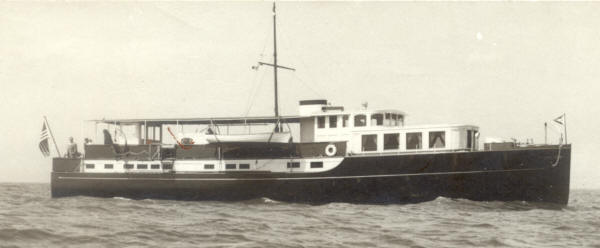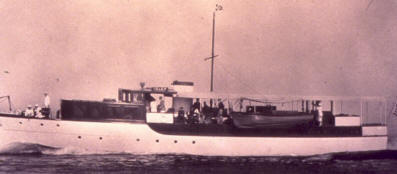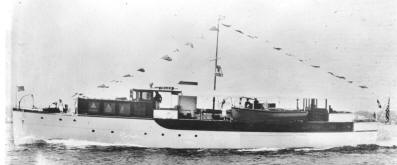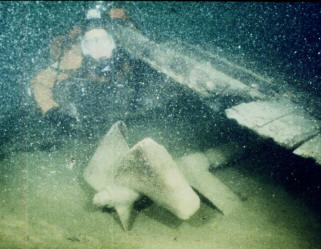The approximate 6,000 ships that have succumbed to raging storms attest to the power of the Great Lakes. As I traveled, writing and compiling information for my three-volume travel series that explores Michigan's coasts, I heard or read the tales left behind by those ill-fated ships. They add a somber, but compelling backdrop to Michigan’s waterways.

In the summer of 1995, two shipwreck hunters dove into the chilly waters of Lake Michigan off South Haven. For several years, they had searched for the elusive remains of the Chicora. What the divers found was not the Chicora, but the remains of the long-forgotten yacht Verano. Originally christened the Idler, then the Paulo Reese II by a subsequent owner, she was finally renamed the Verano, which is Spanish for summer.
She was an American-built ship whose main birthright was luxury. The discovery of her bones rekindled an interest in the opulence of her era. Jazz filled the Chicago nights. The newly rich had money to spend—and spend they did. A fancy yacht put only a minor dent in their huge savings accounts. In exchange, the expenditure bestowed a lavish source of pleasure as they traveled uplake and downlake in a vessel that broadcast their wealth. The Verano changed ownership several times in her 21-year life.

On August 28, 1946, the Verano’s good times plunged to an end. Three months earlier, Maynard Dowell had become the yacht’s final owner. His new $75,000 (in 1946 dollars) purchase was in serious need of repair, and Dowell was having her piloted to Holland’s Jesiek Boat Yard. Jesiek’s was the only yard that could handle a 92-foot, 69-ton, twin-engine power yacht.
Dowell was right to worry that his new toy needed some work. Perhaps she looked better from the outside than from her innards. In the past, she had been known to leak and list. She was said to roll slowly, and require serious efforts by well-trained seamen to bring her upright. The leak problem had, on occasion, required removing deck planks and then bailing. When she took on water, it dragged her stern down.

The overhaul was in anticipation of a trip down the Mississippi River into the Gulf of Mexico that Dowell planned to take in the fall. Holland was only 90 miles from South Haven, and the proud new owner entrusted the transport of his recent acquisition to three men: Chester Granath, an engineering associate of his; Fred Stenning, also an engineer; and Ben Murasaki, a cook. None of the three was well-trained to handle the ship, and none knew the peculiarities of the Verano.
The yacht never arrived in Holland, and her disappearance was fraught with mystery and speculation. The lake was calm. A large insurance policy had been taken out on the ship. The Coast Guard arrived before the Verano disappeared beneath the water and saw nothing they could say caused her to go down.
No one was found aboard. The lifeboat was missing.
A few days later, the overturned lifeboat was found with the oars locked in the stowed position. It wasn’t long before the bodies of the three men who had been aboard the Verano washed ashore. One victim had his life jacket on backwards.
Investigators, then and subsequently, have speculated the reasons the Verano sank. Foul play was never established, but sabotage was not immediately ruled out. WWII had ended the prior year, and there was still anti-Japanese sentiment. The cook was Japanese. A more viable cause for the tragedy pointed to signs that the Verano was not seaworthy. The hapless craft may have been doomed by her inexperienced crew.
Retired Coast Guardsman, Bill Herbst, who worked at the South Haven Coast Guard Station the day the Verano sank, got a call from beachgoers. They had spotted a boat they thought was in trouble because it remained in the same spot and didn’t seem to move. Herbst rushed to the area and found the Verano “wallowing in the sea.” He noted that one of the life boats had been lowered. The Verano was so low in the water that Herbst couldn’t safely send anyone aboard to check for crew or passengers. He couldn’t see an obvious reason the ship was taking on water.
Herbst hoped that the missing lifeboat was evidence the crew and passengers had escaped to safety. He notified authorities and an extensive search was immediately underway. Little was found other than the missing lifeboat. The insurance company tried to retrieve the boat to determine the cause of the disaster, but by the time they arrived, the boat had been driven to the bottom, her bow had come off, and she had split in half. The salvage attempt was a dismal failure. Later attempts to determine why the Verano went down were thwarted by damage caused by the unsuccessful salvage attempts.
As for why the men aboard didn’t survive, it is hypothesized that as inexperienced as they were, they thought the boat was going down too fast for them to bail her out or make repairs. They may have tried to launch the lifeboat—and in their clumsy attempt, capsized it.
The Verano’s broken remains—two large engines and a dashboard with the keys still in the ignition—lie off South Haven in about 55 feet of water. With her, rest the secrets of her demise.

Click through to read excerpts from Royce's three books exploring Michigan's coasts:
Julie Albrecht Royce, the Michigan Editor for Wandering Educators recently published a three-book travel series exploring Michigan’s coastlines. Nearly two decades ago, she published two traditional travel books, but found they were quickly outdated. This most recent project focuses on providing travelers with interesting background for the places they plan to visit. Royce has published two novels: Ardent Spirit, historical fiction inspired by the true story of Odawa-French Fur Trader, Magdelaine La Framboise, and PILZ, a legal thriller which drew on her experiences as a First Assistant Attorney General for the State of Michigan. She has written magazine and newspaper articles, and had several short stories included in anthologies. All books available on Amazon.

Help promote Michigan. Books available on Amazon.
All photos courtesy https://www.michiganshipwrecks.org/shipwrecks-2/shipwreck-categories/shipwrecks-found/verano

